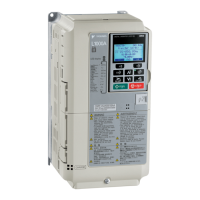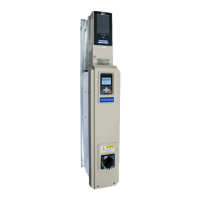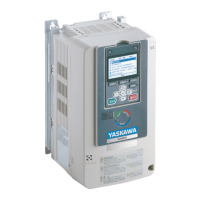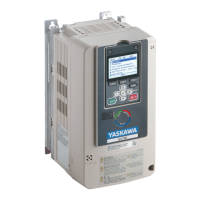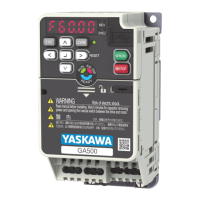7.4 Fault
178 YASKAWA SIEPYEULA5001C LA500 Technical Manual
Code Name Causes Possible Solutions
The drive is trying to operate a specialized motor or
a motor that is larger than the maximum applicable
motor output of the drive.
• Examine the motor nameplate, the motor, and the drive to
make sure that the drive rated current is larger than the motor
rated current.
• Replace the drive with a larger capacity model.
A magnetic contactor was switched at the output. Set the operation sequence to not turn ON or OFF the magnetic
contactor while the drive is outputting voltage.
The V/f pattern settings are incorrect. • Examine the ratios between the V/f pattern frequency and
voltage. Decrease the voltage if it is too high compared to the
frequency.
• Adjust E1-04 to E1-10 [V/f Pattern Parameters]. For motor 2,
adjust E3-04 to E3-10.
The torque compensation gain is too large. Decrease the value set in C4-01 [Torque Compensation Gain] to
make sure that the motor does not stall.
Electrical interference caused a problem. Examine the control circuit lines, main circuit lines, and ground
wiring, and decrease the effects of electrical interference.
The control method is set incorrectly for the motor. Set A1-02 [Control Method Selection] correctly.
The motor main circuit cable is too long. • Replace the drive with a larger capacity model.
• Decrease C6-02 [Carrier Frequency]. Or set C6-02 = B.
Note:
• This fault occurs if the drive sensors detect a drive output current more than the specified overcurrent detection level.
Code Name Causes Possible Solutions
oH Heatsink Overheat
The ambient temperature is high and the heatsink
temperature of the drive is more than the value set
in L8-02 [Overheat Alarm Level].
• Measure the ambient temperature.
• Increase the airflow in the control panel.
• Install a cooling device (cooling fan or air conditioner) to
lower the ambient temperature.
• Remove objects near the drive that are producing too much
heat.
The load is too heavy. • Measure the output current.
• Decrease the load.
• Decrease the value set in C6-02 [Carrier Frequency
Selection].
The internal cooling fan of the drive stopped. 1. Use the procedures in this manual to replace the cooling fan.
2. Set o4-03 = 0 [Fan Operation Time Setting = 0 h].
Note:
• The drive detects this fault if the heatsink temperature of the drive is more than the value set in L8-02.
• Do a Fault Reset to clear the fault.
• If the drive detects this fault, it will operate the motor as specified by the Stopping Method set in L8-03 [Overheat Pre-Alarm Selection].
Code Name Causes Possible Solutions
oH1 Heatsink Overheat
The ambient temperature is high and the heatsink
temperature of the drive is more than the oH1
detection level.
• Measure the ambient temperature.
• Increase the airflow in the control panel.
• Install a cooling device (cooling fan or air conditioner) to
lower the ambient temperature.
• Remove objects near the drive that are producing too much
heat.
The load is too heavy. • Measure the output current.
• Decrease the load.
• Decrease the value set in C6-02 [Carrier Frequency
Selection].
Note:
• The drive detects this fault if the heatsink temperature of the drive is more than the oH1 detection level. o2-04 [Drive Model (KVA) Selection] determines the oH1 detection
level.
• Do a Fault Reset to clear the fault.
• L5-08 [Fault Reset Enable Select Grp2] disables the Auto Restart function.
Code Name Causes Possible Solutions
oL1 Motor Overload
The load is too large. Decrease the load.
Note:
Reset oL1 when U4-16 [Motor oL1 Level] < 100.
The acceleration/deceleration times or cycle times
are too short.
• Examine the acceleration/deceleration times and the motor
start/stop frequencies (cycle times).
• Increase the values set in C1-01 to C1-08 [Acceleration/
Deceleration Times].
Overload occurred while running at low speed. • Decrease the load when running at low speed.
• Increase the motor speed.
• If the motor is run frequently at low speeds, replace the motor
with a larger motor or use a drive-dedicated motor.
Note:
For general-purpose motors, overload can occur while
running at low speed when operating at below the rated
current.

